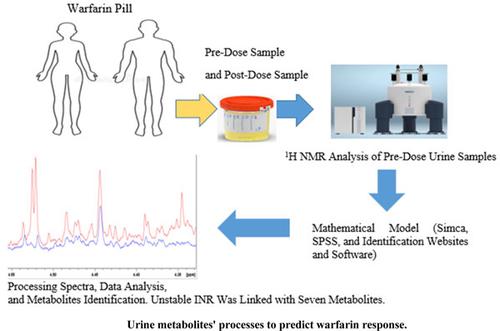当前位置:
X-MOL 学术
›
Curr. Drug Metab.
›
论文详情
Our official English website, www.x-mol.net, welcomes your
feedback! (Note: you will need to create a separate account there.)
Urine Metabolites as a Predictor of Warfarin Response Based on INR in Atrial Fibrillation
Current Drug Metabolism ( IF 2.1 ) Pub Date : 2022-04-15 , DOI: 10.2174/1389200223666220413112649 Abdulkader Ahmad Bawadikji 1 , Chin-Hoe Teh 2 , Muhamad Ali Bin Sheikh Abdul Kader 3 , Syed Azhar Syed Sulaiman 1 , Baharudin Ibrahim 4
Current Drug Metabolism ( IF 2.1 ) Pub Date : 2022-04-15 , DOI: 10.2174/1389200223666220413112649 Abdulkader Ahmad Bawadikji 1 , Chin-Hoe Teh 2 , Muhamad Ali Bin Sheikh Abdul Kader 3 , Syed Azhar Syed Sulaiman 1 , Baharudin Ibrahim 4
Affiliation

|
Background: Warfarin is an anticoagulant with wide inter-individual variations in drug responses monitored based on the International Normalized Ratio (INR). It is commonly prescribed for atrial fibrillation (AF) and stroke. Oral anticoagulants (e.g., warfarin) reduce the risk of getting a stroke but increase the risk of hemorrhage. The proton nuclear magnetic resonance (1H-NMR) pharmacometabonomics technique is useful for determining drug responses. Furthermore, pharmacometabonomics analysis can help identify novel biomarkers of warfarin outcome/ INR stability in urine. Objectives: The focus of this research was to determine if urine metabolites could predict the warfarin response based on INR in patients who were already taking warfarin (identification; phase I) and to determine if urine metabolites could distinguish between unstable and stable INR in patients who had just started taking warfarin (validation; phase II). Methods: A cross-sectional study was conducted. Ninety urine samples were collected for phase 1, with 49 having unstable INR and 41 having stable INR. In phase II, 21 urine samples were obtained, with 13 having an unstable INR and eight having a stable INR. The metabolites associated with unstable INR and stable INR could be determined using univariate and multivariate logistic regression analysis. Results: Multivariate logistic regression (MVLR) analysis showed that unstable INR was linked with seven regions. Discussion: The urine pharmacometabonomics technique utilized could differentiate between the urine metabolite profiles of the patients on warfarin for INR stability. Conclusion: 1H-NMR-based pharmacometabonomics can help lead to a more individualized, controlled side effect for warfarin, thus minimizing undesirable effects in the future.
中文翻译:

尿液代谢物作为心房颤动中基于 INR 的华法林反应的预测因子
背景:华法林是一种抗凝剂,根据国际标准化比率 (INR) 监测的药物反应存在广泛的个体差异。它通常用于治疗心房颤动 (AF) 和中风。口服抗凝剂(如华法林)可降低中风的风险,但会增加出血的风险。质子核磁共振 (1H-NMR) 药物代谢组学技术可用于确定药物反应。此外,药物代谢组学分析可以帮助确定华法林结果/尿液中 INR 稳定性的新生物标志物。目的:本研究的重点是确定尿液代谢物是否可以根据 INR 预测已经服用华法林的患者对华法林的反应(鉴定;I 期)并确定尿液代谢物是否可以区分刚刚开始服用华法林的患者的不稳定和稳定 INR(验证;II 期)。方法:进行了横断面研究。第一阶段收集了 90 个尿样,其中 49 个 INR 不稳定,41 个 INR 稳定。在第二阶段,获得了 21 个尿样,其中 13 个 INR 不稳定,8 个 INR 稳定。与不稳定 INR 和稳定 INR 相关的代谢物可以使用单变量和多变量逻辑回归分析来确定。结果:多变量逻辑回归(MVLR)分析显示不稳定的 INR 与七个区域相关。讨论:使用的尿液药物代谢组学技术可以区分服用华法林的患者的尿液代谢物概况以了解 INR 稳定性。
更新日期:2022-04-15
中文翻译:

尿液代谢物作为心房颤动中基于 INR 的华法林反应的预测因子
背景:华法林是一种抗凝剂,根据国际标准化比率 (INR) 监测的药物反应存在广泛的个体差异。它通常用于治疗心房颤动 (AF) 和中风。口服抗凝剂(如华法林)可降低中风的风险,但会增加出血的风险。质子核磁共振 (1H-NMR) 药物代谢组学技术可用于确定药物反应。此外,药物代谢组学分析可以帮助确定华法林结果/尿液中 INR 稳定性的新生物标志物。目的:本研究的重点是确定尿液代谢物是否可以根据 INR 预测已经服用华法林的患者对华法林的反应(鉴定;I 期)并确定尿液代谢物是否可以区分刚刚开始服用华法林的患者的不稳定和稳定 INR(验证;II 期)。方法:进行了横断面研究。第一阶段收集了 90 个尿样,其中 49 个 INR 不稳定,41 个 INR 稳定。在第二阶段,获得了 21 个尿样,其中 13 个 INR 不稳定,8 个 INR 稳定。与不稳定 INR 和稳定 INR 相关的代谢物可以使用单变量和多变量逻辑回归分析来确定。结果:多变量逻辑回归(MVLR)分析显示不稳定的 INR 与七个区域相关。讨论:使用的尿液药物代谢组学技术可以区分服用华法林的患者的尿液代谢物概况以了解 INR 稳定性。











































 京公网安备 11010802027423号
京公网安备 11010802027423号